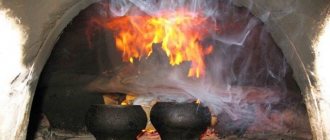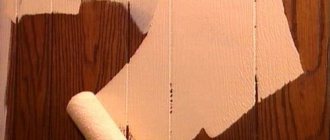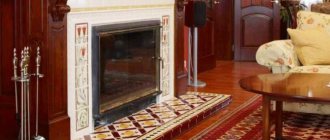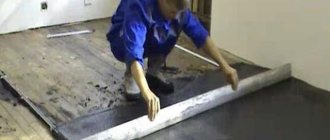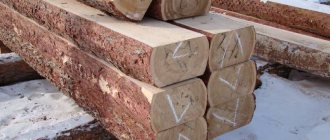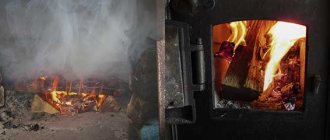Only at first glance it seems that a sauna stove is a simple structure that you can put together yourself. This will require professional skills and many years of experience.
Sometimes even a store-bought stove starts smoking after the first fire. Increased smoke in the room makes it impossible to breathe.
Smoking stove in a bathhouse
It is not always possible to fix the problem yourself; a complete redevelopment of the bathhouse or complex repairs may be required. The reason for the return of smoke back into the chimney and its further spread throughout the bathhouse is often due to external factors - the presence of a nearby wall or tall tree.
Why does the stove smoke in the bathhouse?
The construction of a sauna stove is relatively simple. The design includes 4 functional elements:
- ash pan - a chamber located under the firebox, ash and ash accumulate here - the remains of burnt wood or coal, it should be cleaned periodically;
- firebox - a chamber where fuel burns, air is heated, which then, moving through the chimney channels, heats the walls of the housing, the combustion chamber and the ash pan are separated by a grate;
- chimney pipe - a channel through which gaseous combustion products are discharged outside; the correct structure of the chimney ensures draft;
- A heater is a device unique only to a sauna stove; it is a container with stones that heat up from the body, accumulate heat and release it to the air, but more evenly and much longer than a metal stove does.
If there is no draft in the bathhouse, the cause is any violation in the operation or structure of the structural elements, with the exception of the heater.
Errors in the design of the furnace leading to smoke
If, at the first attempt to light the stove in the bathhouse, smoke comes out, this indicates design errors. It is recommended to immediately contact a specialist:
- poor draft in a sauna stove most often appears when there is an error in the chimney design, channel cross-section, height of the device, internal surface - these parameters determine the functionality of the structure;
- the second fundamental mistake is thermal insulation, in the combustion chamber the gas has a very high temperature, rising through the pipe, it cools when it comes into contact with the walls of the chimney in the bathhouse, if the temperature drops too much, the smoke comes back; the chimney pipe, especially a metal one, must be carefully insulated;
- The stove itself needs to be thermally insulated: if the bath area is large or the steam room and dressing room are heated at the same time, the body loses a lot of heat and the smoke cools;
- tightness - we are talking about seams and doors; the firebox and ash pan must close tightly to ensure good traction.
Important! If smoke does not appear in the bathhouse immediately, but after several years of operation, this does not indicate a design error, but a malfunction or exhaustion of the resource.
Pipe length
The height of the chimney in the bathhouse matters. It must rise above the ridge of the building, otherwise the draft will not be enough for normal operation of the furnace. The smoke exhaust structure is protected with a metal cap. If it is not there, strong winds can easily penetrate inside and prevent smoke from being removed.
Another design error is the location of the smoke exhaust duct at the same level as the combustion chamber door or even below it. In this case, normal draft is not enough to prevent the smoke from returning.
The best option is a straight pipe. Deviation from the vertical is allowed, but weakens traction. Turns and angles increase the risk of clogging.
Insufficient chimney cross-section
The dimensions of the stove in the bathhouse depend on the size of the heated room. This parameter determines not only the dimensions of the combustion chamber, but also, accordingly, the diameter of the chimney. These device parameters are of decisive importance:
- if the diameter is too small, the draft is initially good, but during intensive use the narrow pipe simply does not have time to let through a large volume of gas, and the heater in the bathhouse smokes;
- if the diameter is too large, the draft is very poor, it is difficult to light the stove, it smokes almost constantly;
- the shape of the chimney duct also matters, the best option is a round cross-section, turbulences are formed at the corners of the square, they interfere with the escape of smoke, which leads to smoke;
- The narrowing along the smoke exhaust channel significantly impedes the passage of gases, which also causes the draft to overturn.
Important! The best option for a stove in a bathhouse is a steel chimney. However, this option must be thermally insulated, and not only when passing through the ceiling, but along the entire length.
Leaky chimney
Cracks in the brickwork or burning through the seams of a metal chimney makes it leaky. This is a very dangerous problem, since through such openings smoke enters the room, and in an inconspicuous amount. The user does not feel the appearance of carbon monoxide, and the latter at a minimum concentration can lead to death.
Also, sparks get inside the steam room through the joints, and this threatens a fire in the bathhouse.
Against the background of such dangers, traction failure does not seem to be a serious problem. However, it is also present. Repair of sauna stoves includes inspection of joints and seams for tightness and elimination of violations.
The chimney is clogged
The inner surface must be smooth so as not to interfere with the release of gases. Along with the smoke, some of the ash also comes out through the chimney. If the inside surface of the channel is uneven, ash and soot remain on the walls, gradually clogging the chimney.
At first, this does not affect traction at all. However, accumulations of soot on the walls, especially if the pipe is brick, provoke increased ash deposition. The process accelerates, and after a short time the stove begins to smoke.
An additional danger for a bathhouse is the risk of soot igniting when hit by an accidental spark.
Diagnosis and elimination of faulty ventilation system
The steam room in the bathhouse is not a sealed room. Natural ventilation is usually installed here, since forced ventilation creates too thin air. The system consists of openings for inflow and outflow. The latter are placed at different heights, and the difference in air temperature in the steam room and outside provides the necessary movement.
Malfunctions of the ventilation system are obvious:
- in the steam room, the inlet opening is located at a height of 15 cm from the floor so that the incoming air has time to warm up as much as possible; otherwise the steam room does not heat up, no matter how hard the stove is heated;
- an outflow hole is formed on the opposite wall, otherwise there is no air movement, and the stove, having ceased to receive the required volume of oxygen, begins to smoke;
- the outlet hole must be higher than the supply hole, since warm air is lighter; if this requirement is not met, the ventilation in the bathhouse again does not work;
- the openings are protected with grilles to detect clogging of the ventilation ducts; if the latter occurs, the operation of the system is disrupted.
Important! A stove in a bathhouse with poor ventilation does not develop enough power and begins to smoke after some time when there is not enough air.
The situation can be corrected by creating the correct ventilation system. If the configuration of the steam room or the entire bath is complex, experts recommend installing forced ventilation.
Smoke due to damage to the oven body
If there is draft in the chimney and combustion chamber, the cause of smoke may be damage to the housing. Most often this happens with a metal structure. There are a lot of welds here, and if one of them is made poorly, smoke from the firebox enters the room.
Over time, the seams on the metal product overheat, and the heater smokes after several years of use. Repairing a metal sauna stove is the only way out in this situation.
Another reason is insufficient thermal insulation not only of the chimney in the bathhouse, but also of the stove body. With weak initial draft, overcooling of the furnace leads to cooling of the gases. The draft disappears and the heater smokes.
A possible reason is insufficient sealing of the cleaning doors. If they do not close tightly, sufficient draft force is not generated.
The stove in the bathhouse smokes when the door is open
In the correct design of a heater, there is always traction. So if the stove in the bathhouse smokes through the open door, this indicates that the draft has turned over. The most common case is a clogged chimney, but it is not quite common.
If the chimney gradually becomes dirty, the draft decreases gradually. If a brick version is installed, and the stove has been in use for a long time, there is a risk of brick collapse. When a fragment gets inside the chimney or below, the operation of the heater is disrupted, and smoke goes into the firebox.
The blower is not long enough
Fuel requires air to burn. It is supplied to the grate, where coal or wood is burned, through a ash pit, that is, an ash pan. The air supply is controlled by the doors. When the stove is lit, the door is opened slightly to allow for a stronger fire. When the fuel should simply smolder, the inflow is reduced by closing the door.
The ash pan should have the same dimensions as the grate. Poor draft in a sauna stove occurs if the vent is smaller in area.
The air ducts in the furnace are clogged
If the stove in the bathhouse heats not only the steam room, but also the dressing room and rest room, it is equipped with air ducts. For a small area this is a completely acceptable option. Air ducts become clogged over time. They are more difficult to clean since they are mostly horizontal structures.
To clean the air ducts, potato peels are burned in the firebox. At the same time, you can see white flakes flying out of the pipe on the roof - a sign of cleansing.
You can also periodically heat it with aspen wood. Wood of this type is very wet, which leads to the soot layer becoming wet and falling off.
Taking a break from using the oven
Sometimes the stove in the bathhouse smokes not because there is some kind of malfunction, but because it is used too rarely. If the bathhouse is heated once a week, then the firebox cools down so much that the gas does not warm up enough to rise up the chimney.
It is recommended to first warm up the pipe by burning straw, paper or other fuel that burns quickly in the firebox.
What should you do if you detect smoke?
If a potbelly stove smokes, then we can definitely say that the design has a faulty draft, which is an important parameter for the stove’s performance. However, there can be a huge number of reasons that could contribute to impaired cravings. Smoke may appear during lighting of the stove or be present constantly, however, in any case, you first need to determine the cause of the malfunction of the potbelly stove, and then begin repair work.
It is important to know that if smoke comes from the stove, then this violation will not only negatively affect the health of people living in the house or constantly present in the garage where the potbelly stove is installed, but can also pose a danger to human life.
The first step when detecting smoke is to check all the channels through which the smoke moves, and you should also carefully examine the entire body of the stove, since holes or cracks may form on it, and significant and difficult-to-correct errors could have been made during laying.
Other reasons
There are other reasons why cravings disappear and the stove in the bathhouse begins to smoke intensely. In such a situation, not only internal factors are at work - design errors, clogging, but also external ones:
- wind – strong gusts of wind lead to smoke being thrown into the oven; having lost the ability to move upward, the smoke goes into the room, this problem is easily solved by the installation of chimneys or weather vanes, the devices prevent the ingress of water and snow;
- high humidity - at the same time the atmospheric pressure decreases, and the smoke becomes denser, it moves very reluctantly, this phenomenon can be seen during fog: the smoke spreads along the roof and returns back at the slightest gust of wind;
- the hotter the sun shines, the worse the draft; the temperature difference between the smoke in the chimney and the air outside is too small to create draft, and at temperatures above 35 degrees, capsizing occurs.
Sometimes, to prevent smoke, you just need to light the stove correctly.
Presence of cracks
It's no secret that over the years the stove becomes covered with a network of cracks and cracks.
Especially at the junction of clay and metal elements, for example, around a slab. Wells can also crack at the seams. The cracks could remain in the place where a knockout brick is inserted for cleaning, or the vent and firebox doors have become loose over time.
Also, atmospheric phenomena sometimes destroy the outer part of the pipe on the roof.
It is possible and necessary to deal with cracks, because air is sucked in, its natural flow is disrupted, and at the slightest disturbance in draft for other reasons, smoke finds its way out, even with the door closed!
The cracks are sealed with clay mortar, similar to the one on which the stove is made. Deep cracks are widened using a knife or similar tool to allow the mortar to penetrate deeper between the bricks. Then the gap is moistened with water and sealed well. Small cracks can be whitened.
How to remove back draft in a chimney
Problems with traction in the bathhouse are divided into 2 categories: those associated with errors in the design and those that appear during operation.
The first includes the illiterate structure of the chimney. If its diameter is too small, or the pipe has narrowings, then the only way to solve the problem is to completely disassemble the device.
Group 2 includes situations when the draft disappears due to clogging of the chimney pipe, filling of the ash pan, or loss of tightness. Repairing the sauna stove or cleaning it completely eliminates the problem.
The owner of the bathhouse can eliminate some of the reasons for the draft tipping over on his own:
- clogging of the chimney in the bathhouse - the operating rules oblige the owner to clean the chimney or invite workers to do this, clean the chimney mechanically - using a brush on a cable, or burning with wood; flammable liquids cannot be used;
- if the chimney is made of brick or ceramic, you can reduce clogging by installing a metal sleeve inside it; its walls are smooth, soot is deposited here with difficulty, so you will have to clean the pipe much less often;
- tightness - all detected cracks or leaky joints should be immediately covered with sealant, if the stones of the brick heater are cracked or the same thing happened to the chimney, alas, the stove will have to be completely disassembled;
- if the chimney pipe or the stove itself is overcooled, it is necessary to improve the thermal insulation, the body is plastered, the chimney is insulated with special materials;
- if the ash pan is too long, the wind from the street hits the wall of the combustion chamber and pushes smoke into the room, this problem is solved by filling part of the ash pan with bricks; if the ash pan is short, the latter is remade.
For more complex problems, turn to an experienced stove maker.
What is an “air lock” and how to fix it?
A little smoke when lighting the stove is acceptable. The so-called air lock becomes an obstacle to the normal movement of the flow of warm gases. It is formed due to low temperature and high humidity in the steam room after the furnace has completely cooled down and is idle.
It is “cured” quite quickly. Pay attention to the most effective and common methods:
· Burn several sheets of newsprint rolled into a rope in the firebox. The process takes a couple of minutes, but you still have to inhale a little smoke.
· Before lighting the stove, place a lit candle in the firebox. After 10–15 minutes you can start igniting.
· Direct a hair dryer into the chimney connection pipe; it will blow out the cork in 1-2 minutes.
You can order fireproof cuttings and protective screens for sauna stoves on the official website. Our consultants will talk about installation requirements and answer all questions.
Source
How to increase draft in a sauna stove
If inspection of the stove in the bathhouse does not reveal any problems, but the draft is still weak, you can resort to additional methods:
- instead of a conventional cap, a smoke vane or deflector is mounted on the chimney; this device allows you to use the wind as an additional exhaust hood;
- An electric smoke fan can be installed in the chimney duct; it creates forced draft under any conditions, the disadvantage is dependence on electricity and the need to protect the cable.
Home craftsmen independently develop weather vanes and traction amplifiers of various designs.
Wind
A temporary cause of backdraft can be the wind, the direction and strength of which “drives” the smoke back into the chimney. Tall trees or buildings located near the house can contribute to this.
Install an umbrella or deflector on the top edge of the pipe. These devices significantly improve draft, protect from rain and prevent the wind from blowing smoke back into the chimney.
To date, many deflector designs have been developed. There are rotating models that are themselves installed by the force of the wind so that there is no interference with the smoke.
Many people are interested in the question: how to line an iron stove with bricks? Read useful information in our article. For information on self-repair of Ariston water heaters, see here.
Read about winter kits for air conditioners at this link.
The stove in the bathhouse is smoking, what to do: tips
Traction stalls occur for a variety of reasons. It is impossible to immediately determine what exactly led to the smoke. But there are several simple proven methods:
- first, ventilate the bathhouse in order to equalize the air temperature and pressure inside and outside the building, because if the flat roof of the bathhouse gets too hot, this leads to the draft overturning;
- mechanical obstacles - when igniting the stove, the damper must be open, as well as the vents on the chimney, if any, an overfilled combustion chamber or ash pan also does not allow creating draft, a snow cap on the chimney will also not allow the heater to light;
- to generate draft, they achieve rarefaction of the air inside the pipe; to do this, it is enough to burn a little paper in the firebox.
Important! To warm up the chimney or create a vacuum, do not use liquid flammable materials such as gasoline or kerosene. Otherwise, a fire is inevitable.
Briefly about the main thing
Stove heating in a private house or bathhouse is reliable and economical. However, sooner or later, each user is faced with the problem of loss of draft and smoke formation indoors. The reason for this may be the following problems with the stove itself:
- Creating a backdraft effect.
- Accumulation of soot deposits on the walls of the chimney.
- Accumulation of dampness in the chimney duct.
- Use of unsuitable or low-quality fuel.
- Formation of defects in the chimney or firebox.
- Violation of the integrity of the chimney channel.
In each case, there may be several reasons why the stove in a private house smokes, why the draft has become poor, as well as what to do and what specific actions to take to troubleshoot problems and prevent them in the future.
Ratings 0
Smell from under the floor
The underfloor area may smell like either stagnant sewage or rotting floorboards.
Why does sewage smell? The sewer drain is clogged, there was an error in the installation of the sewer system.
How to get rid of smell from under the floor
1. Take it for granted: in case of smell from under the floor, no fragrances or special disinfectants will help. It is necessary to open the floor and find out the cause of the stagnant water. Perhaps the sewer system is made without a water seal (this is also a siphon), it needs to be redone. 2. Replace rotten or moldy boards.
